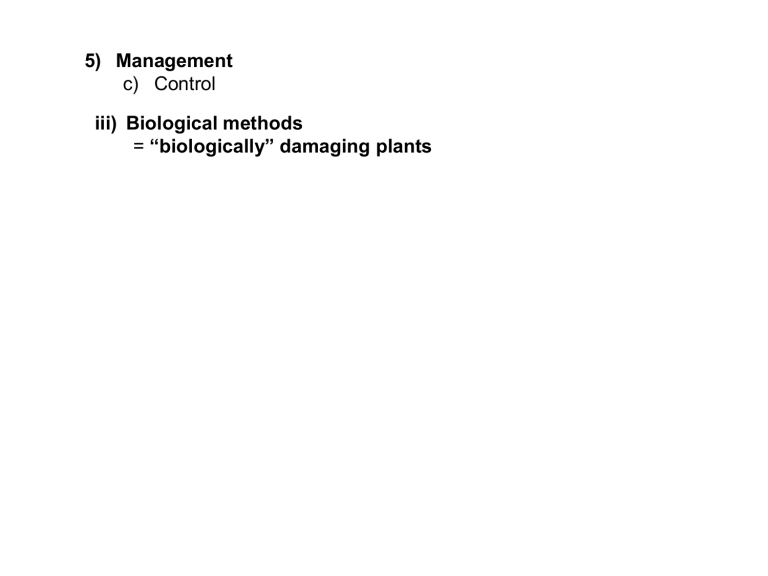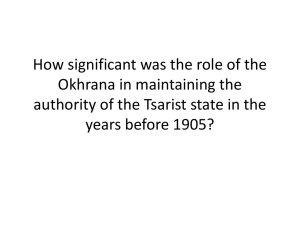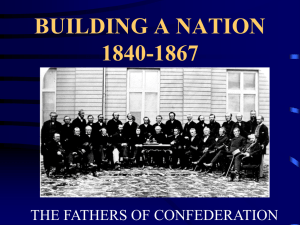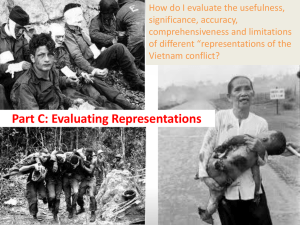Biological control

5) Management c) Control iii) Biological methods
= “biologically” damaging plants
5) Management c) Control iii) Biological methods
= “biologically” damaging plants
Biotic constraints/enemy release hypothesis
5) Management c) Control iii) Biological methods
= “biologically” damaging plants
Biotic constraints/enemy release hypothesis
If plants are invasive because they have escaped natural enemies, introducing the natural enemies should help control the invasive!
5) Management c) Control iii) Biological methods
• Least public opposition
5) Management c) Control iii) Biological methods
• Least public opposition
• Recall Federal Plant Protection Act :
Biological control is often desirable
5) Management c) Control iii) Biological methods
• Least public opposition
• Recall Nevada noxious weed legislation:
•
Weed control analyst researches biological control options
5) Management c) Control iii) Biological methods
• Least public opposition
• Number of success stories
Prickly pear ( Opuntia spp.) in Australia
W. Wagner@USDA-NRCS Plants Database
5) Management c) Control iii) Biological methods
• Least public opposition
• Number of success stories
Prickly pear ( Opuntia spp.) in Australia
Chronology (source: http://www.northwestweeds.nsw.gov.au
)
W. Wagner@USDA-NRCS Plants Database
5) Management c) Control iii) Biological methods
• Least public opposition
• Number of success stories
Prickly pear ( Opuntia spp.) in Australia
Chronology (source: http://www.northwestweeds.nsw.gov.au
)
• Introduced in 1788 with the First Fleet – dye industry
• Additional introductions for forage and hedges though 1800s
• Numerous species
•
Problem acknowledged 1870 W. Wagner@USDA-NRCS Plants Database
5) Management c) Control iii) Biological methods
• Least public opposition
• Number of success stories
Prickly pear ( Opuntia spp.) in Australia
Chronology (source: http://www.northwestweeds.nsw.gov.au
)
• Introduced in 1788 with the First Fleet – dye industry
• Additional introductions for forage and hedges though 1800s
• Numerous species
•
Problem acknowledged 1870
• 1886: prickly pear destruction act
• 1910: ‘Roberts Improved Pear Poison’ created – 80% sulfuric acid, 20% arsenic – considered best weapon
5) Management c) Control iii) Biological methods
• Least public opposition
• Number of success stories
Prickly pear ( Opuntia spp.) in Australia
Chronology (source: http://www.northwestweeds.nsw.gov.au
)
• Early chemical control: fumes from boiling arsenic
Photo: © L. R. Tanner
5) Management c) Control iii) Biological methods
• Least public opposition
• Number of success stories
Prickly pear ( Opuntia spp.) in Australia
Chronology (source: http://www.northwestweeds.nsw.gov.au
)
• Early chemical control: boiling arsenic
• 1912 problem rampant: begin looking for biological control
5) Management c) Control iii) Biological methods
• Least public opposition
• Number of success stories
Prickly pear ( Opuntia spp.) in Australia
Chronology (source: http://www.northwestweeds.nsw.gov.au
)
• Early chemical control: boiling arsenic
• 1912 problem rampant: begin looking for biological control
Photo: © L. R. Tanner
5) Management c) Control iii) Biological methods
• Least public opposition
• Number of success stories
Prickly pear ( Opuntia spp.) in Australia
Chronology (source: http://www.northwestweeds.nsw.gov.au
)
• Early chemical control: boiling arsenic
• 1912 problem rampant: begin looking for biological control
• 1925, infested twenty-five million hectares in New South Wales and Queensland. It was spreading at the rate of half a million hectares a year.
5) Management c) Control iii) Biological methods
• Least public opposition
• Number of success stories
Prickly pear ( Opuntia spp.) in Australia
Chronology (source: http://www.northwestweeds.nsw.gov.au
)
• 1926 introduction of Cactoblastis moth
Photo: © L. R. Tanner
5) Management c) Control iii) Biological methods
• Least public opposition
• Number of success stories
Prickly pear ( Opuntia spp.) in Australia
Chronology (source: http://www.northwestweeds.nsw.gov.au
)
• 1926 introduction of Cactoblastis moth
• By 1932, most of the prickly pear stands had been decimated.
Photo: © L. R. Tanner
5) Management c) Control iii) Biological methods
• Least public opposition
• Number of success stories
Prickly pear ( Opuntia spp.) in Australia
Chronology (source: http://www.northwestweeds.nsw.gov.au
)
• 1926 introduction of Cactoblastis moth
• By 1932, most of the prickly pear stands had been decimated
Photo: © L. R. Tanner
5) Management c) Control iii) Biological methods
• Least public opposition
• Number of success stories
Prickly pear ( Opuntia spp.) in Australia
• Summary: spectacularly successful BUT
• Took 14 years to find biocontrol agent (1912-1926)
• Some cool-climate stands remained; insect less effective
5) Management c) Control iii) Biological methods
• Least public opposition
• Number of success stories
Prickly pear ( Opuntia spp.) in Australia
• Summary: spectacularly successful BUT
• Took 14 years to find biocontrol agent (1912-1926)
• Some cool-climate stands remained; insect less effective
• Opuntia aurantica becomes more problematic 1930-1950
5) Management c) Control iii) Biological methods
• Least public opposition
• Number of success stories
•
Klamath weed ( Hypericum perforatum ) in California
5) Management c) Control iii) Biological methods
• Least public opposition
• Number of success stories
•
Klamath weed ( Hypericum perforatum ) in California
• Broad-leaved, perennial herb
• Introduced from Europe in 1793; reached California late 1800’s
• Extremely invasive; toxic
• By early 1940’s: 5 million acres of infested rangeland
•
Biological control in California: 1945-1950 @ $750,000 total cost
• By early 1960’s insects had reduced acreage to <1% of peak
5) Management c) Control iii) Biological methods
• Least public opposition
• Number of success stories
•
Tamarix in western US:
Photos: Bob Conrad, NAES
5) Management c) Control iii) Biological methods
• Least public opposition
• Number of success stories
•
Tamarix in western US:
• SourceL Swedhin et al. 2006 (Tamarisk Research Conference,
Fort Collins CO)
• Large scale dispersal and population expansion of Diorhabda elongata in CO, NV, and UT after initial releases
•
Near Moab: two release sites in 2004. In 2005, less than 2 acres of tamarisk defoliated. In 2006, 109 acres defoliated, 4.1 miles upstream from release sites and area was expanding
• Expansion of beetles from UT release sites on Colorado River into CO expected by summer 2007
5) Management c) Control iii) Biological methods
• Least public opposition
• Number of success stories
•
Considerations:
5) Management c) Control iii) Biological methods
• Least public opposition
• Number of success stories
•
Considerations:
• Finding an enemy
5) Management c) Control iii) Biological methods
• Least public opposition
• Number of success stories
•
Considerations:
• Finding an enemy
• ID promising species in native range
• Test for host specificity
• USDA has facilities in other countries for this purpose
• http://www.ars-ebcl.org/
5) Management c) Control iii) Biological methods
• Least public opposition
• Number of success stories
•
Considerations:
• Finding an enemy
• ID promising species in native range
• Test for host specificity
• USDA has facilities in other countries for this purpose
• http://www.ars-ebcl.org/
• e.g. Montpelier, France
Current projects:
Canada Thistle, Field Bindweed
Giant reed, Knapweeds, Leafy
Spurge, Lepidium draba , Rush
Skeletonweed, Saltcedar, Swallowworts, Yellow Starthistle
Photo © USDA ARS-EBCL
5) Management c) Control iii) Biological methods
• Least public opposition
• Number of success stories
•
Considerations:
• Finding an enemy
• ID promising species in native range
• Test for host specificity
• USDA has facilities in other countries for this purpose
• http://www.ars-ebcl.org/
• e.g. Montpelier, France
• Also Rome, Italy and Thessaloniki, Greece
Photos © USDA ARS-EBCL
5) Management c) Control iii) Biological methods
• Least public opposition
• Number of success stories
•
Considerations:
• Finding an enemy
• Host specificity : specialists not generalists
5) Management c) Control iii) Biological methods
• Least public opposition
• Number of success stories
•
Considerations:
• Finding an enemy
• Host specificity
• Mode of action (plant part affected)
5) Management c) Control iii) Biological methods
• Least public opposition
• Number of success stories
•
Considerations:
• Finding an enemy
• Host specificity
• Mode of action (plant part affected)
• Type of organism (disease, insect)
5) Management c) Control iii) Biological methods
• Least public opposition
• Number of success stories
•
Considerations:
• Finding an enemy
• Host specificity
• Mode of action (plant part affected)
• Type of organism (disease, insect)
•
Climate requirements of organism (climate matching for source populations and introduction sites)
• e.g. some releases of Diorhabda from Texas populations not successful at higher latitudes – couldn’t overwinter
5) Management c) Control iii) Biological methods
• Least public opposition
• Number of success stories
•
Considerations:
• Finding an enemy
• Host specificity
• Mode of action (plant part affected)
• Type of organism (disease, insect)
•
Climate requirements of organism (climate matching for source populations and introduction sites)
• Estimated that about ½ of introduced weed bio-control insect species establish in new location
5) Management c) Control iii) Biological methods
• Least public opposition
• Number of success stories
•
Considerations:
• Finding an enemy
• Non-target effects
5) Management c) Control iii) Biological methods
• Least public opposition
• Number of success stories
•
Considerations:
• Finding an enemy
• Non-target effects
• Specificity of biocontrol agent
• Relatedness of flora
5) Management c) Control iii) Biological methods
• Least public opposition
• Number of success stories
•
Considerations:
• Non-target effects – Pemberton (2000)
5) Management c) Control iii) Biological methods
• Least public opposition
• Number of success stories
•
Considerations:
• Non-target effects
5) Management c) Control iii) Biological methods
• Least public opposition
• Number of success stories
•
Considerations
• Non-target effects
5) Management c) Control iii) Biological methods
• Least public opposition
• Number of success stories
•
Considerations
• Non-target effects
5) Management c) Control iii) Biological methods
• Least public opposition
• Number of success stories
•
Considerations
• Non-target effects
5) Management c) Control iii) Biological methods
• Least public opposition
• Number of success stories
•
Considerations
• Non-target effects
5) Management c) Control iii) Biological methods
• Least public opposition
• Number of success stories
•
Considerations
• Non-target effects
5) Management c) Control iii) Biological methods
• Least public opposition
• Number of success stories
•
Considerations
• Non-target effects
5) Management c) Control iii) Biological methods
• Least public opposition
• Number of success stories
•
Considerations
• Non-target effects
5) Management c) Control iii) Biological methods
• Least public opposition
• Number of success stories
•
Difficulty locating enemy
• Non-target effects – From Pemberton (2000)
5) Management c) Control iii) Biological methods
• Least public opposition
• Number of success stories
•
Difficulty locating enemy
• Non-target effects – From Pemberton (2000)
5) Management c) Control iii) Biological methods
• Least public opposition
• Number of success stories
•
Considerations
• Non-target effects
5) Management c) Control iii) Biological methods
• Least public opposition
• Number of success stories
•
Considerations
• Non-target effects
5) Management c) Control iii) Biological methods
• Least public opposition
• Number of success stories
•
Difficulty locating enemy
• Non-target effects
Most likely a problem when the invasive species has closely related plants in the invaded area







